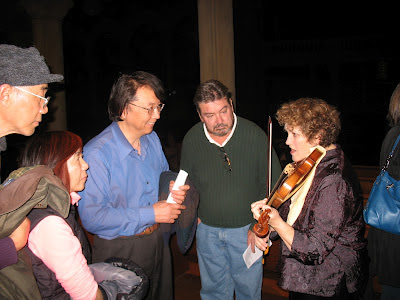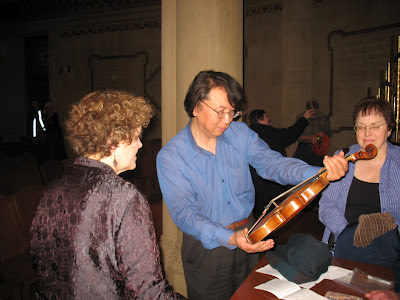
Elaine Thornburgh and Elizabeth Blumenstock
02/20/2012
Schmelzer: Sonata No.4 from Sonatae unarum fidium
Froberger: Lamentation (1657)
Biber: Violin Sonata No.2 (1681 sonatas)
J.S. Bach: Sonata in A major for violin and harpsichord BWV 1015
J.S. Bach: Partita No.1 for solo violin BWV 1002
Balbastre: Pieces de clavecin - La d'Hericourt - La Lugeac - La Castelmore
Leclair: Violin Sonata in B minor Op.5 No.5
又到了老師在學校的年度音樂會。去年那一場,老師獨挑大樑,不過今年她請來了灣區知名的小提琴Elizabeth Blumenstock助陣。她是Musica Pacifica的一員,有Marais的Pieces en Trio的錄音,同時也是Arcadian Academy的成員,在Harmonia Mundi牌子上有Uccellini與Matteis的錄音。最後,她也與John Butt有錄巴哈有伴奏的小提琴奏鳴曲集。Blumenstock女士在聽Philharmonia Baroque的眾多音樂會中就常看她表演了,之前還聽過她拉的四季。
這次讓我期待的,是曲目本身。Schmelzer與Biber的作品,都是我常常在錄音裡聽得愛不釋手的作曲家。巴哈的那兩首曲子,也都沒聽過現場的,所以這次當然要一次大飽「耳」福。
大體上,老師和Blumenstock女士二位在詮釋上都是願意做比較大膽嘗試的音樂家。兩個人合作起來,更有加成的效果。Elizabeth的下弓勁道大,斷句充份,有時動作太大可能會造成音準上的偏差,但音樂性的加分是完全彌補這個小缺失。
Schmelzer和Biber那兩首小提琴奏鳴曲,因為沒有大提琴或是古中提琴,所以數字低音的部份全由Elaine一人扛起。Schmelzer那首的譜的伴奏部份大部份是簡單重覆的四個單音,所以如果只是呆呆地彈那四個音,肯定是會被討打的。Elaine的話,除了將和聲配上,還有呼應小提琴部份的旋律。真正的巴洛克精神,是要當場即興出來的,不過這是極為不易的。Elaine向我透露,她事前都有先做好筆記,是很正常的。
巴哈的A大調奏鳴曲,其實性質更像是三重奏鳴曲,第二高音部為大鍵琴的右手。不過因為小提琴的光芒太強眼了,所以除非小提琴休息或是拉長音,不然大鍵琴的部份是不容易注意到的。
唯一不熟的小提琴奏鳴曲,是Leclair那首。 手邊有Leclair的小提琴奏鳴曲集,但剛好都不是作品五的。從這首聽起來,這首奏鳴曲應該是可以給長笛吹的, 因為沒有雙絃和三絃的部份。我本來期待可以目睹Elizabeth拉一首Leclair有挑戰的奏鳴曲,不過一整晚下來,她們說不定想以輕鬆點的方式收尾。不管奏鳴曲困難不困難,Leclair的法式優雅風是不減的。
Elaine的獨奏部份,其實只有兩部份。第一是Froberger為了悼念Ferdinand三世皇帝過逝而寫的曲子。這是極為嚴肅沉重的一曲,充滿了從恩師Frescobaldi那兒繼承過來的不和諧音,加上Froberger受到法國鍵盤樂的影響,音樂中沒有一絲的歡愉。Elaine在一切的處理都很漂亮,但這種曲風沒有明顯的主題,是較難引起我共鳴的曲子。
但是下半場她的Balbastre,可是讓我非常欣賞。Balbastre的音樂,先前有介紹過。那張錄音裡的音樂是風琴師,所以彈奏方式遠沒有Elaine來得細膩。尤其是音樂轉折中做出適當的暫停,或是和絃的處理,Elaine做得實在是太完美了。而La Castlemore那首musette性質的曲子,Elaine更是運用不同絃的組合,達到音色的變化,讓這些原本就很有性格的曲子上, 變得更是生動。
而Elizabeth,當然也有自己獨秀的機會,也就是巴哈的無伴奏。這首Partita相當有意思,雖然是四首舞曲,但因為加上了double,所以實際上有八首。這些無伴奏,很久沒有好好聽了,所以可當是重新認識。Elizabeth拉的方式,在古樂演奏框架下,再加上她的生命力,去掉了這些音樂可能有的生硬感,突顯了舞曲性質。
這場音樂會,我有向灣區的台灣愛樂人士小小宣傳一下。這天又剛好是President's Day的假期,所以有看到幾位長輩出席。其中Johnny,除了本身拉小提琴以外,又有修琴的嗜好,非常專業而且認真在經營的。Johnny說是他第一次聽巴洛克小提琴的演奏。不過畢竟是位行家,馬上就注意到巴洛克琴和弓的不同,立刻可了解拉出來的聲音的不同。除了看Elizabeth講解示範她的1660 Guarneri小提琴,他還忍不住得親手摸摸看看才行~~
Elizabeth demonstrating her 1660 Guarneri
Johnny inspecting Elizabeth's violin
This was Elaine's annual concert at Stanford, one of the requirements being appointed by the University. Last year, it was her solo recital, which is typically the way it is. However, this year when she told me that she would be joined by Ms. Elizabeth Blumenstock, I could not have been more exciting. And then, seeing the concert program, it was a sure killer for me!
Of the pieces, the ones I most looked forward to were the Schmelzer and Biber, because I've been such a fan of these works since my first reception of them, and my appreciation of these early Austrian Baroque pieces only runs deeper. To hear them live, was of course, a treat to not be missed. While many recordings get creative on the continuo instrumentation, here they do not have the luxury of that; instead, it falls on Elaine's shoulders completely. This arrangement is most likened to the partnership between Andrew Manze and Richard Egarr, where they released many good recordings of works by Corelli, Handel, Biber, and Pandolfi. While the harpsichord lacks the sustain a cello or organ would bring, it makes up for with clarity and intimacy.
The Schmelzer sonata is my favorite one in the set, and the repeating descending tetrachord in the bass can sound repetitive if not treated properly. Then again, Elaine's playing style is the complete antithesis of monotony. Add to the fact that both Elaine and Elizabeth can really drive the music with conviction, the combined effect is nothing short of exciting. Compared to the performance where Elizabeth played with Voices of Music (which can be found here), which I felt started a bit slower than I would have preferred, Elaine and Elizabeth's playing this night was closer to my heart.
The Bach sonata was again a treat to hear live, one of the pieces that I have heard repeatedly on recordings. As the harpsichord part is fully written out, it's really a trio sonata in texture, but the harpsichord is always going to be at an disadvantage when playing alongside the violin, and the more subtle lines become evident only when the violin is silent or is holding a long note. Elaine switching on the lute stop for the 3rd movement was a nice little touch.
Elizabeth's solo moment was of course, Bach's solo violin partita. This is music I have not gone back to in a long time, so every bit of it, while distantly familiar, was in a way, a new experience here. Especially with Elizabeth's playing, which eschews the heavy approach of modern instrument recordings, brings out the dance-like spirit in the pieces.
Elaine's solo keyboard pieces came in two pockets. The first one was Froberger's Lamentation, a tombeau on Emperor Ferdinand III's death. It's a heavy and solemn piece, leaving no doubt that this is not music for pleasure. It's filled with trademark Frescobaldi sounds, with touches of French influences that Froberger picked up in his journeys. Elaine's treatment was musically immaculate, but it just was not one of my favorite keyboard genres. (not now at least)
I found the second set of pieces much more gratifying, which were Balbastre's character pieces. I am biased towards the French pieces of course, having played quite a few of them over the past few years. I previously reviewed my recording of his pieces, but Elaine's playing this night, especially on the musical side, easily came out as the clear favorite. The turn of the phrase, the brushing of the chords, the changing of the registers, and just the way the music is engaged, just speaks for itself.
Originally I was expecting a virtuosic Leclair sonata to end the concert. However, it seemed like it was one of those pieces that were equally playable on the flute (possibly intended for his good friend Michel Blavet), as there were no double or triple stops. Regardless of the technical challenges underlying, Leclair's French flair radiates out. Starting from the Austrian-German Baroque and ending with the late French, it was a pleasant end to the journey in time and in nationality. Couldn't expect for more on this President's Day evening.


No comments:
Post a Comment